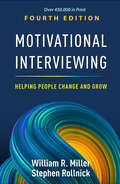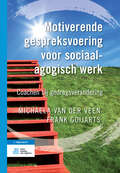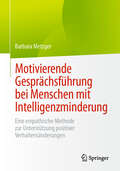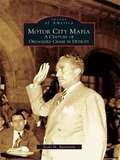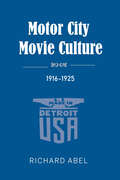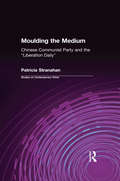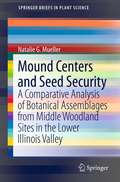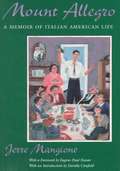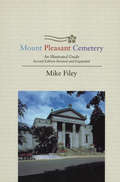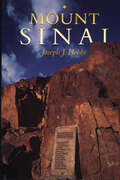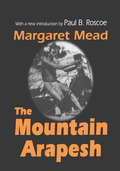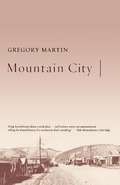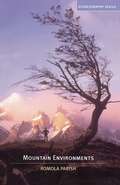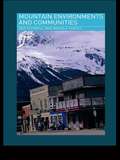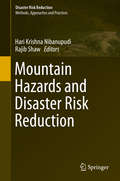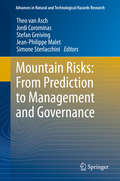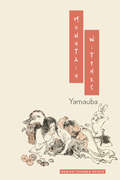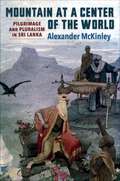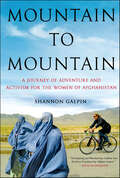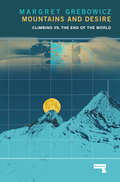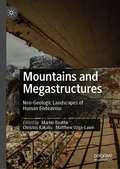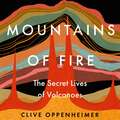- Table View
- List View
Motivational Interviewing: Helping People Change and Grow (Applications of Motivational Interviewing)
by Stephen Rollnick William R. MillerNow in a fully rewritten fourth edition, this is the authoritative presentation of motivational interviewing (MI), the powerful approach to facilitating change. It has been updated and streamlined to be even more user-friendly as a practitioner guide and course text. MI originators William R. Miller and Stephen Rollnick elucidate the four tasks of MI--engaging, focusing, evoking, and planning--and vividly demonstrate what they look like in action. A wealth of vignettes and interview examples illustrate the dos and don'ts of successful implementation in diverse contexts. The book reviews the evidence base for the approach and covers ways to assess the quality of MI. The companion website provides reflection questions, annotated case material, and additional helpful resources. New to This Edition *Most of the book is entirely new. *Addresses the breadth of MI applications not only in counseling and psychotherapy, but also in health care, education, coaching, management, and other contexts. *Discusses delivering MI remotely, simple versus complex affirmations, strategic use of directional questions, ethical considerations, and other new or expanded topics. *Increased emphasis on using MI throughout a client's process of change and growth, not just in the preparatory stage. Pedagogical Features *New or updated online materials, including reflection questions and annotated cases. *Key points at the end of each chapter. *"Personal Perspective" and "For Therapists" boxes in every chapter. *Extensive glossary. *New self-assessment tool that targets the component skills of MI. This book is in the Applications of Motivational Interviewing series, edited by Stephen Rollnick, William R. Miller, and Theresa B. Moyers.
Motive für ein Freiwilliges Soziales Jahr aus biografischer Perspektive (Kasseler Edition Soziale Arbeit #25)
by Tim WersigDer Band untersucht die Motivbildung für ein Freiwilliges Soziales Jahr (FSJ) bei jungen Erwachsenen und Jugendlichen. Im Fokus der empirischen Auseinandersetzung stehen Lebensgeschichten und biografische Erzählungen derer, die ein Freiwilliges Soziales Jahr planen. Dabei wird untersucht, inwieweit explizite und implizite Motive für die Teilnahme am FSJ mit dem individuellen biografischen Erleben und Geschehen der Freiwilligen verknüpft sind. Zugleich wird analysiert, inwiefern unterschiedliche lebensgeschichtliche als auch lebensverlaufsbezogene Aspekte und Ereignisse sowie Sozialisationsinstanzen für die Motivbildung und Entscheidung für ein FSJ bedeutend erscheinen.
Motiverende gespreksvoering voor sociaalagogisch werk: Coachen bij gedragsverandering
by Michaela Veen Frank GoijartsHoe bouw je een werkbare relatie op? Hoe breng je cliënten zover dat ze er zelf voor kiezen hun gedrag te veranderen? Hoe zorg je ervoor dat ze het gevoel hebben stappen te kunnen zetten op weg naar kansrijker gedrag dat (uiteindelijk) hun eigen welzijn ten goede komt? Hoe bereik je dat het niet alleen bij plannen blijft, maar dat ze de ingezette verandering ook volhouden? Motiverende gespreksvoering voor sociaalagogisch werk biedt een toegankelijke en praktische vertaling van recente inzichten over het beïnvloeden van motivatie en gedrag naar de praktijk van het sociaalagogisch werkveld. 'Motivational Interviewing' zoals ontwikkeld door Miller & Rollnick vormt daarbij de belangrijkste leidraad. Dit boek biedt een gedegen theoretisch begrip van de diverse concepten die aan de gespreksmethode ten grondslag liggen, maar is vooral praktijkgericht. De verschillende stappen in de motiverende benadering worden duidelijk uiteengezet en toegelicht. Er zijn cases en voorbeelddialogen met een toelichting. Op de begeleidende website is aanvullend materiaal beschikbaar in de vorm van reflectievragen, verschillende videovoorbeelden uit de diverse werkvelden, aanvullende dialogen, opdrachten en toetsvragen.
Motivierende Gesprächsführung bei Menschen mit Intelligenzminderung: Eine empathische Methode zur Unterstützung positiver Verhaltensänderungen
by Barbara MetzgerMenschen mit Intelligenzminderung stehen häufig vor besonderen Herausforderungen – sei es in ihrer Lebensgestaltung, in der Kommunikation oder im Umgang mit gesundheitlichen und sozialen Schwierigkeiten. Zugleich fehlt es häufig an geeigneten beraterischen und therapeutischen Konzepten, die auf ihre besonderen Bedürfnisse ausgerichtet sind. Dieses Fachbuch zeigt, wie die bewährte Methode der Motivierenden Gesprächsführung (Motivational Interviewing) speziell für diesen Personenkreis angepasst werden kann. Schritt für Schritt wird beschrieben, wie durch Empathie, Akzeptanz und gezielte Kommunikationsstrategien Veränderungsmotivation geweckt und nachhaltige Fortschritte erreicht werden können – und das ohne Druck und Zwang. Mit anschaulichen Ablaufplänen, Fallbeispielen, praxiserprobten Gesprächsmethoden und wissenschaftlich fundierten Hintergrundinformationen richtet sich dieses Buch an Fachkräfte, Angehörige und alle, die Menschen mit Intelligenzminderung auf ihrem Weg zu mehr Selbstbestimmung und Lebensqualität begleiten möchten. Ein wertvoller Leitfaden für eine respektvolle und erfolgreiche Unterstützung positiver Veränderungen.
Motor City Mafia: A Century of Organized Crime in Detroit (Images of America)
by Scott M. BurnsteinMotor City Mafia: A Century of Organized Crime in Detroit chronicles the storied and hallowed gangland history of the notorious Detroit underworld. Scott M. Burnstein takes the reader inside the belly of the beast, tracking the bloodshed, exploits, and leadership of the southeast Michigan crime syndicate as never before seen in print. Through a stunning array of rare archival photographs and images, Motor City Mafia captures Detroit's most infamous past, from its inception in the early part of the 20th century, through the years when the iconic Purple Gang ruled the city's streets during Prohibition, through the 1930s and the formation of the local Italian mafia, and the Detroit crime family's glory days in the 1950s, 1960s, and 1970s, all the way to the downfall of the area's mob reign in the 1980s and 1990s.
Motor City Movie Culture, 1916–1925
by Richard AbelA study of how the film industry came to flourish in Detroit in the early years as locals were lured into the new picture theaters. Motor City Movie Culture, 1916–1925 is a broad textured look at Hollywood coming of age in a city with a burgeoning population and complex demographics. Richard Abel investigates the role of local Detroit organizations in producing, distributing, exhibiting, and publicizing films in an effort to make moviegoing part of everyday life. Tapping a wealth of primary source material—from newspapers, spatiotemporal maps, and city directories to rare trade journals, theater programs, and local newsreels—Abel shows how entrepreneurs worked to lure moviegoers from Detroit&’s diverse ethnic neighborhoods into the theaters. Covering topics such as distribution, programming practices, nonfiction film, and movie coverage in local newspapers, with entr&’actes that dive deeper into the roles of key individuals and organizations, this book examines how efforts in regional metropolitan cities like Detroit worked alongside California studios and New York head offices to bolster a mass culture of moviegoing in the United States.
Motor City Movie Culture, 1916–1925
by Richard AbelA study of how the film industry came to flourish in Detroit in the early years as locals were lured into the new picture theaters. Motor City Movie Culture, 1916–1925 is a broad textured look at Hollywood coming of age in a city with a burgeoning population and complex demographics. Richard Abel investigates the role of local Detroit organizations in producing, distributing, exhibiting, and publicizing films in an effort to make moviegoing part of everyday life. Tapping a wealth of primary source material—from newspapers, spatiotemporal maps, and city directories to rare trade journals, theater programs, and local newsreels—Abel shows how entrepreneurs worked to lure moviegoers from Detroit&’s diverse ethnic neighborhoods into the theaters. Covering topics such as distribution, programming practices, nonfiction film, and movie coverage in local newspapers, with entr&’actes that dive deeper into the roles of key individuals and organizations, this book examines how efforts in regional metropolitan cities like Detroit worked alongside California studios and New York head offices to bolster a mass culture of moviegoing in the United States.
Moulding the Medium: Chinese Communist Party and the "Liberation Daily"
by Patricia StranahanIntroduces to researchers the content of the Chinese Communist Party's first official newspaper, the Liberation daily, and examines its role in the acceptance and implementation of the party's goals during its span from May 1941 to March 1947. Includes chronological and topical outlines of the paper
Mound Centers and Seed Security
by Natalie G. MuellerAt Middle Woodland sites in the eastern United States, excavations have uncovered naturalistic art worked on exotic materials from points as distant Wyoming, Ontario, and the Gulf Coast, revealing a network of ritual exchange referred to as the Hopewell phenomenon. Simultaneously, Middle Woodland societies developed the earliest agricultural system in eastern North American using now-extinct native cultivars. Mound Centers and Seed Security: A Comparative Analysis of Botanical Assemblages from Middle Woodland Sites in the Lower Illinois Valley integrates an interpretation of these two historical trends. Unlike most journal articles on related subjects, the volume includes a lengthy review of literature on both Hopewell studies and Middle Woodland agriculture, making it a useful resource for researchers starting out in either field. Synthesizing both original research and research reported in archaeological "grey literature", Mound Centers and Seed Security: A Comparative Analysis of Botanical Assemblages from Middle Woodland Sites in the Lower Illinois Valley is a valuable tool for researchers and teachers alike.
Mount Allegro: A Memoir of Italian American Life
by Jerre MangioneMount Allegro is an extraordinary memoir, a celebration of Sicilian life, an engaging sociological portrait, a moving reminiscence of a fledgling writer's escape from the restrictive culture in which he grew up. Jerre Mangione's autobiographical chronicle of his youth in a Sicilian Community in Rochester is one of the truly enduring books about the immigrant experience in this country. Family squabbles, soul-nourishing food, and the casting of evil eyes are only some of the ingredients of this richly textured book, although they must all take second place to its unforgettable characters. As Eugene Paul Nassar writes in the book's Foreword, "Mount Allegro . . . gave a literary visibility and identity, amiable and appealing, to a poorly understood ethnic group in America, and did so at a very high level of artistry. " Book jacket.
Mount Pleasant Cemetery: Second Edition, Revised and Expanded
by Mike FileyEstablished in 1876, Mount Pleasant Cemetery has a rich and textured history. It is the keeper of thousands of stories, each of which has contributed to the history of our city, province, and country.Many of Canada’s most beloved figures rest there - William Lyon Mackenzie King, Foster Hewitt, Glenn Gould, and Timothy Eaton are just a few. Other, less known historical figures are buried there also - the first Canadian soldier killed in First World War and victims of the 1949 Noronic disaster.Along with a fascinating account of the cemetery’s history, this illustrated guide includes descriptions of the remarkable monuments and the beautiful horticultural features. Accompanying maps detailing their locations make this book a perfect companion for a walking tour through the grounds.
Mount Sinai
by Joseph J. HobbsAmid the high mountains of Egypt's southern Sinai Peninsula stands Jebel Musa, "Mount Moses," revered by most Christians and Muslims as Mount Sinai. (Jewish tradition holds that Mount Sinai should remain terra incognita, unlocated, and does not associate it with this mountain.) In this fascinating study, Joseph Hobbs draws on geography and archaeology, Biblical and Quranic accounts, and the experiences of people ranging from Christian monks to Bedouin shepherds to casual tourists to explore why this mountain came to be revered as a sacred place and how that very perception now threatens its fragile ecology and its sense of holy solitude. After discussing the physical characteristics of Jebel Musa and the debate that selected it as the most probable Mount Sinai, Hobbs fully describes all Christian and Muslim sacred sites around the mountain. He views Mount Sinai from the perspectives of the centuries-long inhabitants of the region—the monks of the Monastery of St. Katherine and the Jabaliya Bedouins—and of tourists and pilgrims, from medieval Europeans to modern travelers dispirited by Western industrialization. Hobbs concludes his account with the recent international debate over whether to build a cable car on Mount Sinai and with an unflinching description of the negative impact of tourism on the delicate desert environment. His book raises important, troubling questions for everyone concerned about the fate of the earth's wild and sacred places.
Mountain Arapesh: Socio-economic Life And Diary Of Events In Alitoa
by Margaret MeadFor approximately eight months during 1931-1932, anthropologist Margaret Mead lived with and studied the Mountain Arapesh-a segment of the population of the East Sepik Province, Papua New Guinea. She found a culture based on simplicity, sensitivity, and cooperation. In contrast to the aggressive Arapesh who lived on the plains, both the men and the women of the mountain settlements were found to be, in Mead's word, maternal. The Mountain Arapesh exhibited qualities that many might consider feminine: they were, in general, passive, affectionate, and peaceloving. Though Mead partially explains the male's "femininity" as being due to the type of nourishment available to the Arapesh, she maintains social conditioning to be a factor in the type of lifestyle led by both sexes. Mead's study encapsulates all aspects of the Arapesh culture. She discusses betrothal and marriage customs, sexuality, gender roles, diet, religion, arts, agriculture, and rites of passage. In possibly a portent for the breakdown of traditional roles and beliefs in the latter part of the twentieth century, Mead discusses the purpose of rites of passage in maintaining societal values and social control. Mead also discovered that both male and female parents took an active role in raising their children. Furthermore, it was found that there were few conflicts over property: the Arapesh, having no concept of land ownership, maintained a peaceful existence with each other. In his new introduction to The Mountain Arapesh, Paul B. Roscoe assesses the importance of Mead's work in light of modern anthropological and ethnographic research, as well as how it fits into her own canon of writings. Roscoe discusses findings he culled from a trip to Papua New Guinea in 1991 to clarify some ambiguities in Mead's work. His travels also served to help reconstruct what had happened to the Arapesh since Mead's historic visit in the early 1930s.
Mountain City
by Gregory MartinThis book offers a very honest and open description of the people and things that makes this small Mountain town live and breathe. It brings to life the people who live there, work there and die there. An excellent insight on humanity.
Mountain Environments (Ecogeography Series)
by Romola ParishThis book breaks the ground in Geographical texts by transcending a strictly regional or topical focus. It presents the opportunities and constraints that mountains and their resources offer to local and global populations; the impacts of environmental and economic change, development and globalisation on mountain environments. Part of the Ecogeography series edited by Richard Hugget
Mountain Environments and Communities (Routledge Physical Environment Ser.)
by Romola Parish Don FunnellMountain Environments and Communities explains the background physical environment and then explores the environmental and social dimensions of mountain regions.This critical review of the concepts currently employed in mountain research, draws upon a wide range of examples from developed and developing countries. The dynamics of mountain life are described through both historical accounts of village-based systems and examples of the contemporary impact of global capital and sustainable development strategies.
Mountain Environments in Changing Climates
by Martin BenistonHome to large numbers of people, sources of water, centres of tourism, and sensitive ecological zones, mountain environments share distinctive climactic characteristics. Once regarded as economically non-viable regions, mountains now attract major investment as sites of tourism, hydro-power and communication routes. This book brings together some of the current work on the physical and human ecology of mountain environments, the impacts of climate change, the processes involved and their observation and prediction.
Mountain Hazards and Disaster Risk Reduction
by Rajib Shaw Hari Krishna NibanupudiThe Hindu Kush Himalayan (HKH) region is highly vulnerable to earthquakes and water-induced disasters. This fragile mountain region is under tremendous stress from climate change and land-use degradation that has accelerated flash floods, river-line floods, erosion, and wet mass movements during the monsoon period and drought in the non-monsoon period. Against the backdrop of intensifying disasters and in the absence of a focused documentation of disaster risk reduction issues in the HKH region, this volume presents a comprehensive body of knowledge. The main purpose and objective of this publication is to connect existing data, research, conceptual work, and practical cases on risk, resilience, and risk reduction from the HKH region under a common analytical umbrella. The result is a contribution to advancing disaster resilience and risk reduction in the HKH region. The book will be of special interest to policy makers, donors, and researchers concerned with the disaster issues in the region.
Mountain Risks: From Prediction to Management and Governance
by Stefan Greiving Theo Van Asch Jordi Corominas Jean-Philippe Malet Simone SterlacchiniThis book offers a cross disciplinary treatment of the rapidly growing field of integrated approaches in risk assessment in mountainous areas. All major aspects related to hazard and risk assessment, risk management, and governance are illustrated with a wide range of case studies. The first part of the book focuses on new techniques for assessing the natural hazards of different types of mass movements. State-of-the-art techniques for morphological characterization and monitoring of displacements are described. Computational advances are covered to explain the process systems and to quantify the hazards of fast and slow-moving landslides. In the second part of the book methodologies are included for assessing the impact of these natural hazards on the society in terms of risks. In this part, methodologies for defining the vulnerability of the elements at risk are shown and the use of run-out models for risk assessment of the dangerous rapid mass movements are evaluated. The third part of the book focuses on the response of society towards the problems of hazard and risk. It highlights the role of spatial planning, early warning systems and evacuation plans for risk management. It establishes practical thresholds for acceptable and tolerable risks and emphasizes the importance of education and communication to society. Audience The book is of interest to a wide range of experts from related disciplines, practitioners and stakeholders to demonstrate the importance of an integrated approach for all aspects of risks in mountainous areas.
Mountain Witches: Yamauba
by Noriko T. ReiderMountain Witches is a comprehensive guide to the complex figure of yamauba—female yōkai often translated as mountain witches, who are commonly described as tall, enigmatic women with long hair, piercing eyes, and large mouths that open from ear to ear and who live in the mountains—and the evolution of their roles and significance in Japanese culture and society from the premodern era to the present. In recent years yamauba have attracted much attention among scholars of women’s literature as women unconstrained by conformative norms or social expectations, but this is the first book to demonstrate how these figures contribute to folklore, Japanese studies, cultural studies, and gender studies. Situating the yamauba within the construct of yōkai and archetypes, Noriko T. Reider investigates the yamauba attributes through the examination of narratives including folktales, literary works, legends, modern fiction, manga, and anime. She traces the lineage of a yamauba image from the seventh-century text Kojiki to the streets of Shibuya, Tokyo, and explores its emergence as well as its various, often conflicting, characteristics. Reider also examines the adaptation and re-creation of the prototype in diverse media such as modern fiction, film, manga, anime, and fashion in relation to the changing status of women in Japanese society. Offering a comprehensive overview of the development of the yamauba as a literary and mythic trope, Mountain Witches is a study of an archetype that endures in Japanese media and folklore. It will be valuable to students, scholars, and the general reader interested in folklore, Japanese literature, demonology, history, anthropology, cultural studies, gender studies, and the visual and performing arts.
Mountain at a Center of the World: Pilgrimage and Pluralism in Sri Lanka
by Alexander McKinleyAt the pilgrimage site of Adam’s Peak in Sri Lanka, a footprint is embedded atop the mountain summit. Buddhists hold that it was left by the Buddha, Hindus say Lord Siva, and Muslims and Christians identify it with Adam, the first man. The Sri Lankan state, for its part, often uses the Peak as a prop to convey a harmonious image of religious pluralism, despite increasing Buddhist hegemony. How should the diversity of this place be understood historically and managed practically?Considering the varied heritage of this sacred site, Alexander McKinley develops a new account of pluralism based in political ecology, representing the full array of actors and issues on the mountain. From its diverse people to rare species to deep geology, the Peak exemplifies a planetary pluralism that recognizes a multiplicity of beings while accepting competition and disorder. Taking a place-based approach, McKinley casts the mountain as an actor, exploring how its rocks, forests, and waters promote pilgrimage, inspire storytelling, and make ethical demands on human communities. Combining history and ethnography while furnishing original translations of sources from Pali, Sinhala, and Tamil, this multidisciplinary and stylistically innovative book shows how religious traditions share literal common ground in their reverence for the mountain.
Mountain to Mountain: A Journey of Adventure and Activism for the Women of Afghanistan
by Shannon GalpinBeing inspired to act can take many forms. For some it's taking a weekend to volunteer, but for Shannon Galpin, it meant leaving her career, selling her house, launching a nonprofit and committing her life to advancing education and opportunity for women and girls. Focusing on the war-torn country of Afghanistan, Galpin and her organization, Mountain2Mountain, have touched the lives of hundreds of men, women and children. As if launching a nonprofit wasn't enough, in 2009 Galpin became the first woman to ride a mountain bike in Afghanistan. Now she's using that initial bike ride to gain awareness around the country, encouraging people to use their bikes "as a vehicle for social change and justice to support a country where women don't have the right to ride a bike."In Mountain to Mountain, her lyric and honest memoir, Galpin describes her first forays into fundraising, her deep desire to help women and girls halfway across the world, her love for adventure and sports, and her own inspiration to be so much more than just another rape victim. During her numerous trips to Afghanistan, Shannon reaches out to politicians and journalists as well as everyday Afghans — teachers, prison inmates, mothers, daughters — to cross a cultural divide and find common ground. She narrates harrowing encounters, exhilarating bike rides, humorous episodes, and the heartbreak inherent in a country that is still recovering from decades of war and occupation.
Mountains and Desire: Climbing vs. The End of the World
by Margret GrebowiczOn the 100th anniversary of the first attempt to climb Mt Everest, Margret Grebowicz shows how and why climbing and mountaineering are still important today.In 1923, a reporter asked George Mallory why he wanted to summit Mount Everest. &“Because it&’s there&”. Today the question "why do this?" is included in nearly every mountaineering story or interview. Meanwhile, interest in climbing is steadily on the rise, from commercial mountaineering and climbing walls in university gyms and corporate workplaces to the flood of spectacular climbing imagery in advertising, cinema, and social media. Climbing has become the theater for imagining limits—of the human body and of the planet— and the nature of desire, motivation, and #goals.Covering the degradation of Everest, the banning of climbing on Australia&’s Uluru, UNESCO&’s decision to name alpinism an Intangible Cultural Heritage, the sudden death of Ueli Steck, and the commercial and critical success of Free Solo, Mountains and Desire chases after what remains of this pursuit – marred by its colonial history, coopted by nationalistic chauvinism, ableism, and the capitalist compulsion to unlimited growth – for both climbers and their fans.
Mountains and Megastructures: Neo-Geologic Landscapes of Human Endeavour
by Christos Kakalis Martin Beattie Matthew Ozga-LawnThis book explores the shared qualities of mountains as naturally-formed landscapes, and of megastructures as manmade landscapes, seeking to unravel how each can be understood as an open system of complex network relationships (human, natural and artificial). By looking at mountains and megastructures in an interchangeable way, the book negotiates the fixed boundaries of natural and artificial worlds, to suggest a more complex relationship between landscape and architecture. It suggests an ecological understanding of the interconnectedness of architecture and landscape, and an entangled network of relations. Urban, colonialist, fictional, rural and historical landscapes are interwoven into this fabric that also involves discontinuities, tensions and conflicts as parts of a system that is never linear, but rather fluid and organic as driven by human endeavor.
Mountains of Fire: The Secret Lives of Volcanoes
by Clive OppenheimerA thrilling journey to the planet's most extreme places with volcanologist and filmmaker Professor Clive Oppenheimer, revealing how volcanoes have shaped us and our planet.Volcanoes mean more than threat and calamity. Like our parents, they've led whole lives before we get to know them. They have inspired our imaginations, provoked pioneering explorations and shaped the path of humanity.World-renowned volcanologist Clive Oppenheimer has worked at the crater's edge in the wildest places on Earth, from remote peaks in the Sahara to mystical mountains in North Korea. He's faced down AK47s, learned from tribal elders, and watched red hot rocks shoot into the sky. More people have been into space than have set eyes on the fiery depths of Mount Erebus in Antarctica, where he has measured the Earth's powerful forces. In Mountains of Fire, he paints volcanoes as otherworldly, magical places where our history is laid bare, and shows us just how entangled volcanic activity is with our climate, economy, politics, culture and beliefs.In a stunning blend of science, cultural history, myth and adventure, Mountains of Fire pulls out new lines of causation and correlation stretching around the globe, and reveals how deeply our stories are intertwined.(P) 2023 Hodder & Stoughton Limited
